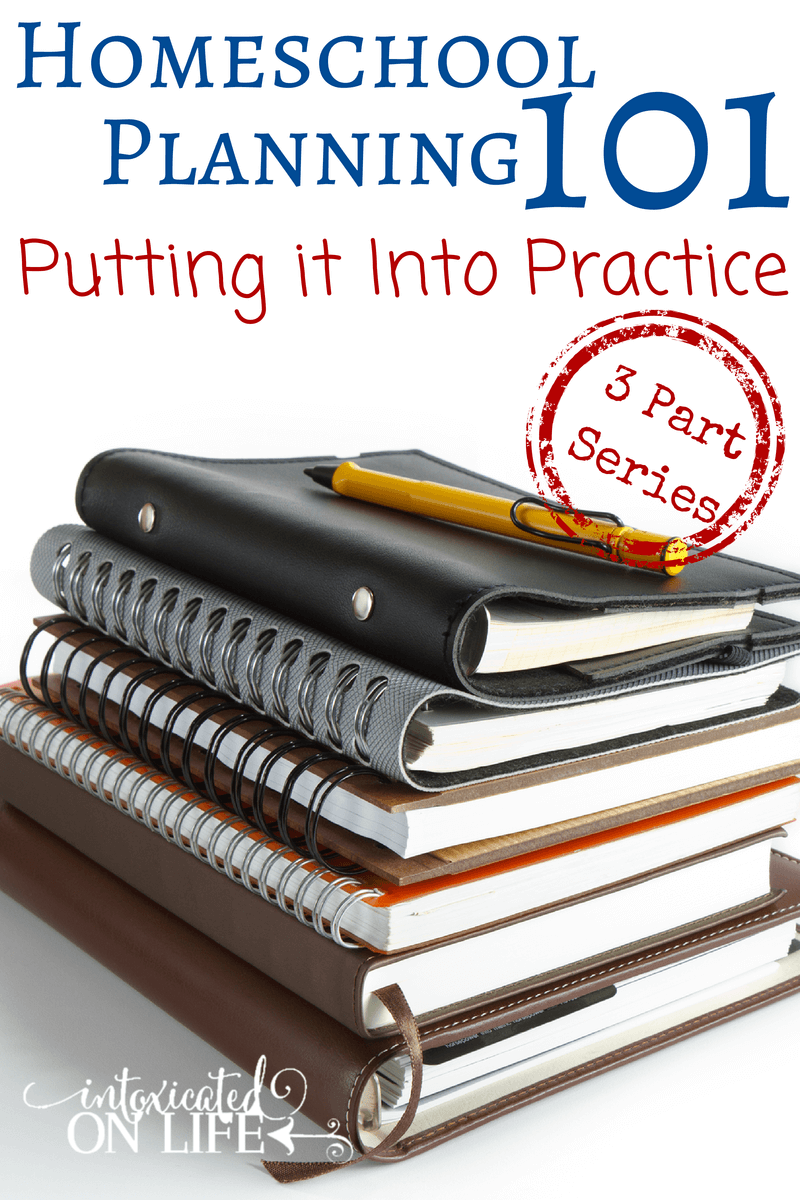The last two weeks we have focused on homeschooling goals and touched on planning your schedule. Now it’s time to fill in the details to make this a workable transition and transformation for your family.
Keep in mind: life happens. While we work with the details, keep your own family’s day-in and day-out rhythms at the front or your thoughts. Do you have a husband who works strange hours? Do you have children with delayed developmental issues? Do you struggle yourself because you have many, many little ones all needing different things on different levels? How this plan works out, needs to work first with you and your husband, then your children, because if it creates a conflict from the start, it will not work.
So let’s get to this! I like to do all of my planning on real paper with a pencil. I find that it helps me figure things out easier. When I am done with this, I put in into the computer or create a final copy that is a little fancier for all to see. Grab you pencil and paper, now!
Plan Your End of Year Results
What does this mean? This means to work backwards when writing out your specific details.
For instance, you need to finish a certain number of books in this year, or you want to get to a certain point in writing, math, grammar, spelling and science. In other words, you have an idea of what you’d like to see accomplished at the end of the year.
Start with these thoughts in mind, and on paper. You may write all of these things out on a piece of paper or wherever you like to take notes. Whatever you choose, you need to have some frame of reference visible for you to start the planning process.
For example, in science we are going through the Apologia Physical Science with my older children. However, we are not working this alone; we are doing this through our local co-op. This means that we need to complete the units with the group, so what the group does will determine how many chapters per week we will do. I don’t have to come up with this plan—I am not the teacher—but I do have to make room in the schedule to allow our work to be done on time. This goes on my paper. If I do not have all the details, I plan the best way I can to make sure we have the time we need filled in.
With math, all of my children are on different levels. During our school day, we choose to work in 1/2-hour increments. So I try to make enough math pages, problems, or flash cards available to fill up that time frame. This helps me gauge my children’s abilities as well. I can see if they need more work in a certain area when they take too much time to work a problem, or I see that they are doing really well and they need more of a challenge if they are finished quickly.
It’s is wise to take a look through the curriculum you are using for math to see where the children will start and where they might end. If your child is far beyond the starting point, do you really need to re-do all of that information? Plan accordingly. Don’t waste your time or your kiddos. Everyone will appreciate a little forethought here. Is it too challenging? Then make the necessary adjustments and get them back into the grove of math at a healthy pace to get them revved for the full curriculum. Are there too many repeats in the program? Nix some of them beforehand. This makes the plan more unique to your child and not the masses. This is a good thing!
Reading aloud as a family we plan for the whole year (including the summertime). I know that we want to cover so many books in the year, so:
- I choose the books I would like to read and see how many pages or chapters they have.
- I determine that I would like to read so many pages or chapters per day (or per week) so I can finish the desired books within the school year and through the summer.
- I also make sure that I read aloud at other moments of the day (such as during lunch and snack times). Reading through books this way allows for some margin time if life gets crazy, but it also allows us to complete more books as a family than if I only read at the “designated time.”
Projects you should list out for the year without much detail and after you have worked out the rough draft, then plan in the days and what you will be doing to finish the project.
Writing out of your brainstormed project ideas will help you know when you may be planning the wrong project for the wrong time of year. If you are wanting an lengthy outdoor project, might it be best to plan it at the beginning of the year, or towards the end of the year in the Spring? Save the indoor projects for the winter, and be sure you do not stress yourself out with too many projects around Thanksgiving and Christmas. The thing we are planning for this year will end up being gifts. Killing two bird with one stone is a great way to homeschool!
Plan Each Term or Month, Week, and Day
You know what you’d like to use for books, math, science, etc. Now you need to work the plan for smaller increments of time to use that book for 12 weeks, or have enough math pages for 9 weeks, plan projects within the term, and have enough to do—but not too much either.
- One can plan all terms ahead or work one term at a time. The benefit of one term at a time is that you can tweak things without reworking the whole year.
- The benefit of planning the whole year is you seem to have a stronger start.
- Do what’s best for you. Either way, at least a rough draft of the year will be helpful.
The best way to fill in the details is to take the amount of chapters or the amount of pages, divide that number by the weeks of your term. Did you decide to take breaks, like 12 weeks on and a couple weeks between the next term? Or 6 or 9 weeks on and one week off? This matters because children and mothers will not usually do to well if a project or book is broken up by a long vacation, most of the time we lose our drive. So try to plan with finishing points in mind.
Let’s say we plan to read 144 books in 1 year (this is just an idea, not reality), then we break it down into terms, 3 groups of 12 weeks: that means 48 books every 12 weeks. We may choose to work months instead, 3 months or 4 months at a time instead of terms. Either way we will end up dividing things up unto weeks, then days.
For Example: 48 books read over three 12 week terms. That would mean 16 books per term. Now we can break it down by chapters or pages read from those books per week. For me, I like chapters: again, there is an end point (I can’t stand to set a book down in the middle of a chapter). Here is where reading at snack times helps.
Let’s say there are an 160 chapters total. (I am counting all the chapters for all 48 books, not just one.) This means that there are on average 10 chapters per book. I need to finish a whole book in a little over a week. If I am reading only 3 times per week, then we need to cover at least 3 chapters per day of reading, plus one extra chapter one of those days. If I spread this out over 5 days this makes it a little more manageable and we end up reading about 2 chapters per day.
It seems tedious, I know, but this help you lay things out so that you know whether you are doing too much or too little.
This works well for whatever it is you have determined for your children’s reading alone time. It’s a great way to include your children in the planning having them determine how many books they might like to read within your desires and their ability, what they might read with approval, etc. and allow them to come up with how they will work this into the family schedule.
One may use this same basic method with any pre-planned curriculum of workbooks. Simply break up the pages into days and appropriates times. You will quickly see if you need to pair down the work or give them more. Let yourself be flexible with your children’s learning ability.
For projects the principle is basically the same. Some projects ideas we pick up from books or curriculum. These usually have a plan that we can break down into days or parts, and place accordingly in your schedule. If you are coming up with your own projects, it is wise to try to lay out some of the details before hand. Then move these details into your schedule in manageable pieces.
Keep plugging away at this one (or multiple) child at a time, one subject at a time. You can do this!
- It will give you breathing space and brain space on those days when you are exhausted or too many people need your attention at once.
- Planning this way allows you and your children to run on auto-pilot with out undue stress on any one of you.
- If something comes up, you can tweak your day—you have my permission—but do you best to let the plan take care of itself while you enjoy the fruits or your labors.
Putting the Plan into Action
Now that we have our details laid out and our schedule, whether flexible or fixed in place, we need to work it. The plan needs to have action! Lofty thoughts get no results until they are put to the test. So put one foot in front of the other. You will quickly find out whether this will work for you or not.
I think it is best to give something a try for at least one month. This means dedicating yourself and your children to trying your new plan no matter what comes.
As you walk through the weeks, write down what worked and what didn’t. Look at those things again from a different angle. Did they work because you were ready the night before? The children got up on time? You had your morning well laid out? Or did they fail because the children were sick? You had an unplanned appointment? Your husband got home early and the children were to distracted to continue?
Evaluating why things worked or didn’t work really helps me get a grip on reality. If the plan worked most of the time then keep on trucking along. Why change a good thing? But if it really didn’t work, most of the time, then you need to evaluate a little more.
Was it you who didn’t work it? The children? What happened? Was it a bad plan? Too much work, or too little? Did you start school at the wrong time of day? Were you ready mamma? Do the children need more order to their lives, more habit training, etc? These things will matter. We are working on some of this here too, so don’t feel alone if you have some downs. It will work out. Just find what works for you and never, ever give up.
Let the Lord Lead
All of these plans are good and helpful but the most important thing to keep in mind is to let the Lord ultimately lead you and your children. You will have bumps in the road. You will have interruptions±plan on that! You will have a perfect picture in your mind of how things are supposed to be and look, it will happen some days, but most of the time, your perfect dream will not be reality.
I do not write this to discourage you but to give you a clear perspective. We are all humans working towards right living with our Lord. He intervenes in our lives to teach us things. There are times that trying to hold on to control is a weakness. Other times not having enough discipline is the weakness. Here He is calling us to live a more scheduled life. The plan can be the tool to bring us to the end of ourselves and rely more heavily on Him for what He desires for us, because it was and is His plan.
I am learning to say no and yes to the things that He wants for me and my children It takes time to change, so be gracious with yourself and keep at life. Giving up is not the same as pressing on, faithfulness, and perseverance. Those are all fruits of the Spirit. A moment of hopelessness or even a week, does not mean that you should end your journey of homeschooling. Look to Jesus, He is the Author and Finisher of your school and your family, as well as your faith.
Keep the Big Picture in mind, and lean on Him for all of this!
What can I do to help you further? Do you need some hand holding with your schedule? If so, let me know and I’d be glad to help! What are ways you have detailed your days that might be different from above? Please comment here.
The Rest of the Series…
Part 1: Setting Your Goals
Part 2: Define Your Focus and Schedule







We love to use Sonlight because it’s a literature rich curriculum and the books are schedule out for me. I used to try and do it all myself, so I love the time it saves me!
Thanks for this article series! 😉
Lori in NY
Lori! So many people I know love Sonlight. I haven’t used them yet but have used their books list. I think it is a great resource.
Thank you for sharing!
~ Amanda